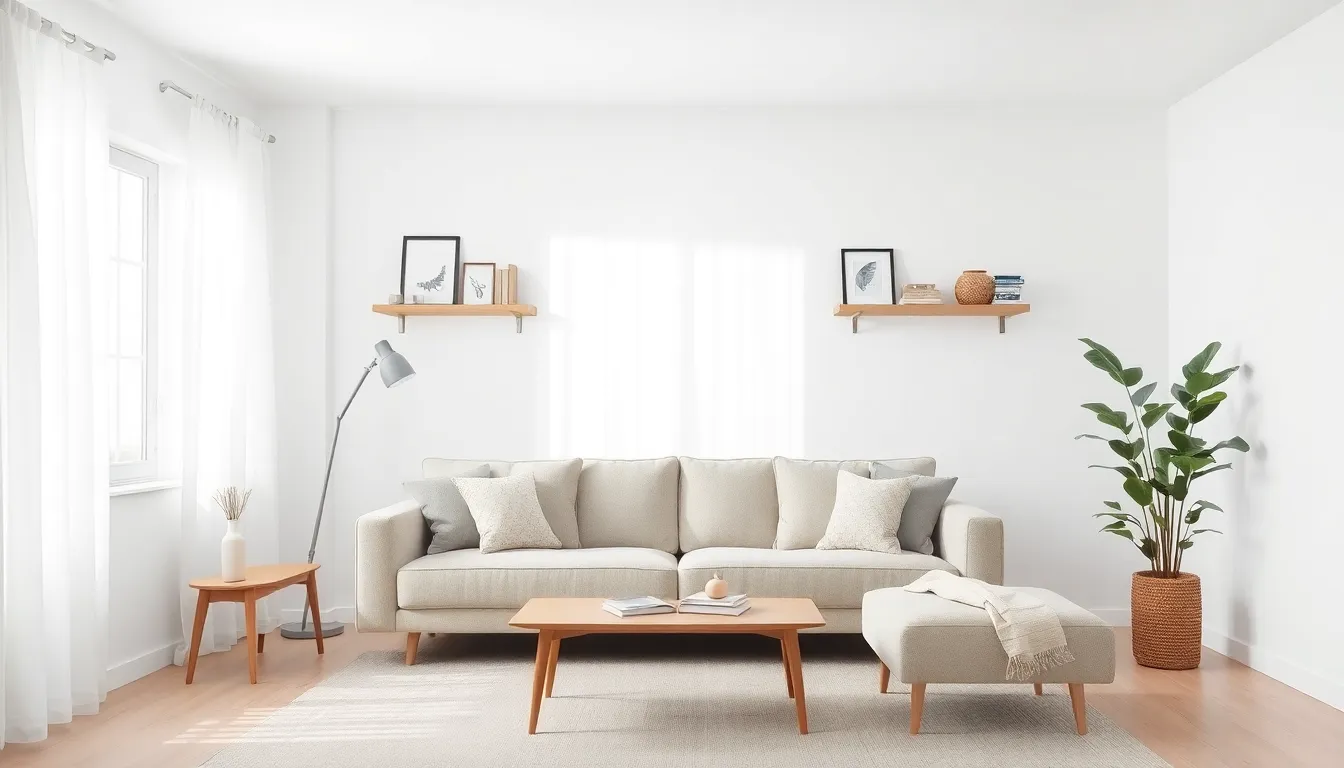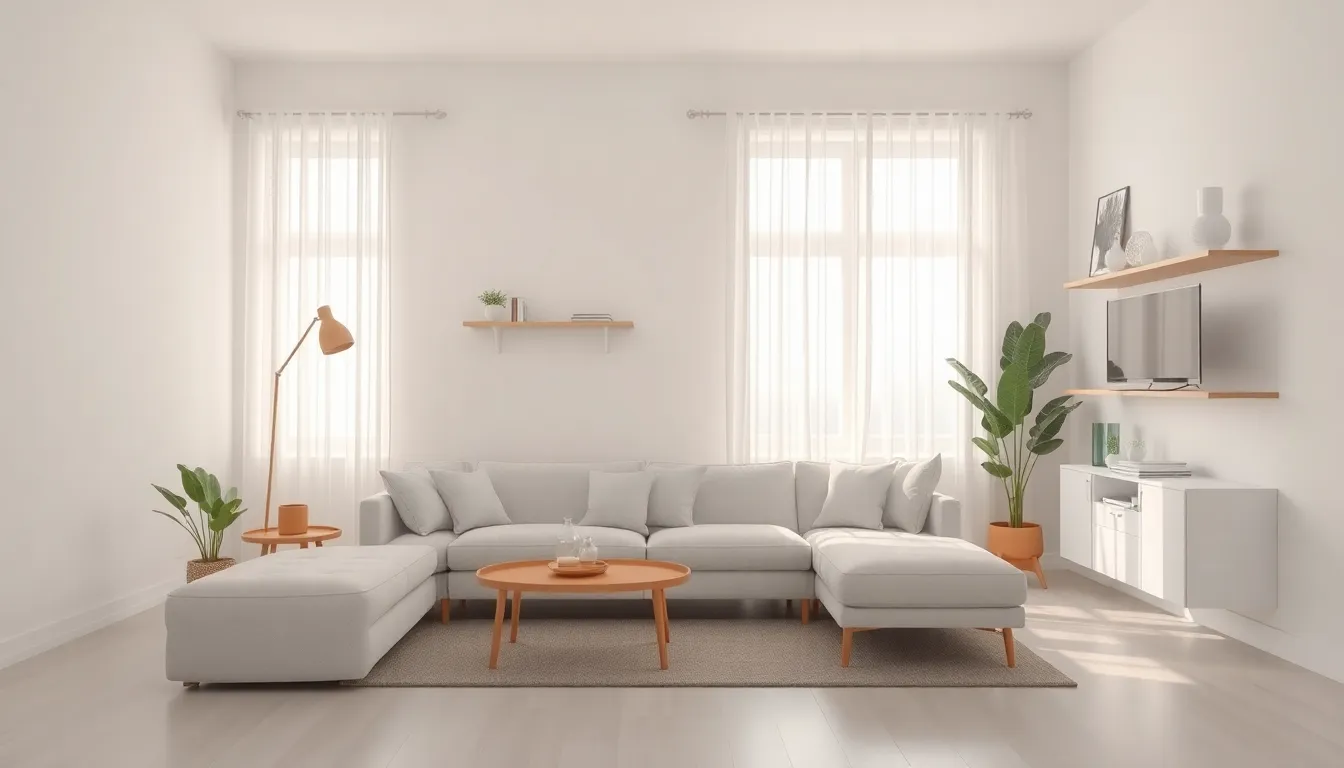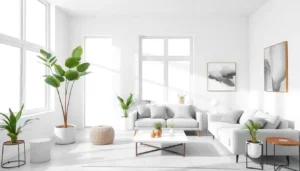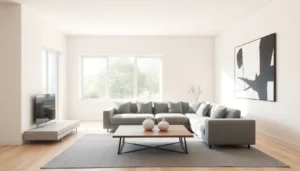Table of Contents
ToggleImagine transforming your living room into a serene sanctuary where less truly is more. With IKEA’s minimalist approach, you can create a space that’s not only stylish but also functional. Gone are the days of cluttered furniture and overwhelming decor. It’s time to embrace simplicity and let your personality shine through subtle design choices.
IKEA Living Room Ideas Minimalist
Transform a living room with IKEA’s minimalist designs. Focus on functional furniture that maximizes space. Choose modular sofas, like the FÄRLÖV, which combines comfort and compact design. Optimize light with sheer curtains to enhance natural brightness.
Incorporate multifunctional pieces such as storage ottomans that blend style with efficiency. Utilize wall-mounted shelves to keep surfaces clear and display decor items. Select a neutral color palette to evoke calmness and simplicity.
For decor, prioritize a few well-placed art pieces or plants to add character without overwhelming the space. Use rugs to define areas while maintaining an open layout. Create a cozy reading nook with minimal accessories—just a chair and a small side table.
Experiment with textures by combining materials like wood, metal, and fabric to add depth. Equip the living room with a slim console table rather than larger furniture, promoting a more airy feel. Utilize IKEA’s design tools for personalized layouts, allowing for easy modifications based on space requirements.
Furnish with intention, aiming for pieces that reflect individual style while remaining practical. This approach creates a harmonious, inviting atmosphere that inspires relaxation. Each choice should contribute to an overall minimalist aesthetic that prioritizes functionality and simplicity.
Key Principles of Minimalism


Minimalism focuses on creating a peaceful and functional living space. It emphasizes simplicity and intentionality in design choices.
Functionality Over Aesthetics
Functional furniture takes precedence over purely decorative pieces. IKEA provides modular options, such as the FÄRLÖV sofa, that balance comfort and space efficiency. Each item should contribute to the living room’s purpose without overcrowding the area. Selecting multifunctional pieces simplifies the layout, allowing for easy movement and adaptability. Prioritizing functionality fosters a streamlined environment conducive to relaxation. Space-saving solutions enhance the usability of the room while maintaining a minimalist appeal. Emphasizing practicality transforms the space into a serene oasis.
Clutter-Free Design
A clutter-free design encourages an airy and open atmosphere. Utilizing wall-mounted shelves offers functional storage without overwhelming surfaces. Each decorative item should serve a purpose, contributing to overall harmony. Arranging furniture thoughtfully enhances the sense of space while eliminating unnecessary items. Sheer curtains help maximize natural light, further promoting a spacious feel. Clear surfaces encourage an organized and peaceful environment. This approach offers visual clarity and a serene aesthetic, reinforcing the minimalist philosophy of simplicity.
Choosing the Right Furniture
Selecting furniture plays a vital role in achieving a minimalist living room. It centers on functionality and simple design elements.
Multi-Functional Pieces
Furniture that serves multiple purposes optimizes both space and efficiency. Storage ottomans offer seating and hidden storage, keeping clutter at bay. Modular sofas, such as the FÄRLÖV, allow for configuration changes based on needs. Coffee tables with built-in shelving can double as storage units, promoting a tidy appearance. Incorporating these elements makes the area more versatile without sacrificing style.
Simple Lines and Shapes
Furniture characterized by clean lines and geometric shapes enhances the minimalist aesthetic. Sofas with sleek silhouettes complement the overall design, contributing to a serene atmosphere. Coffee tables should feature uncomplicated design, creating visual harmony throughout the space. Shelving units that boast straightforward forms add unobtrusive storage without overwhelming the room’s look. Choosing pieces like these fosters a unified, tranquil environment.
Color Palette and Decor
Creating a cohesive and calming color palette enhances the minimalist living room design. This approach prioritizes tranquility and simplicity while incorporating elements that reflect personal style.
Neutral Tones
Neutral tones dominate minimalist living room color schemes. Shades like beige, gray, and soft whites create a serene backdrop for furniture and decor. Choosing these colors makes space feel open and inviting. Balance is vital; light and dark neutral shades work well together. Adding a pop of color through a statement piece, such as a vibrant pillow or an accent chair, introduces visual interest without overwhelming the space.
Minimalist Accessories
Minimalist accessories define a curated living room. Each decorative item serves a purpose, ensuring functionality accompanies aesthetic appeal. Select decor with clean lines and subtle textures, like a sculpture or a simple vase. Incorporating greenery through plants can bring life and freshness to the room while retaining the minimalist ethos. Limit the number of accessories to avoid cluttering surfaces, and choose items that harmonize with the overall design. Thoughtful placement elevates both style and function, maintaining the simplistic elegance of the space.
Arrangement and Layout
Arranging a minimalist living room requires intentionality. Careful layout decisions can optimize space and create a serene atmosphere.
Maximizing Space
Furnishing a room efficiently enhances both functionality and aesthetics. Choosing modular furniture allows for flexibility and adaptability. Storage ottomans serve dual purposes, offering extra seating and concealed storage. Wall-mounted shelves create vertical storage, freeing up floor space for movement. Large area rugs can define zones within open spaces, giving depth without clutter. Maintaining a clutter-free environment maximizes visual openness, facilitating relaxation and comfort.
Creating a Focal Point
Establishing a focal point centers the space and draws attention effectively. A striking piece of art or a bold statement furniture piece often serves this purpose best. Positioning a sofa centrally invites conversation while also serving as a visual anchor. Minimalist designs favor singular, impactful elements, avoiding overwhelming viewers. Plants or carefully arranged accessories provide organic interest without distraction. Balancing the focal point with surrounding elements ensures visual harmony while reinforcing the minimalist aesthetic.










